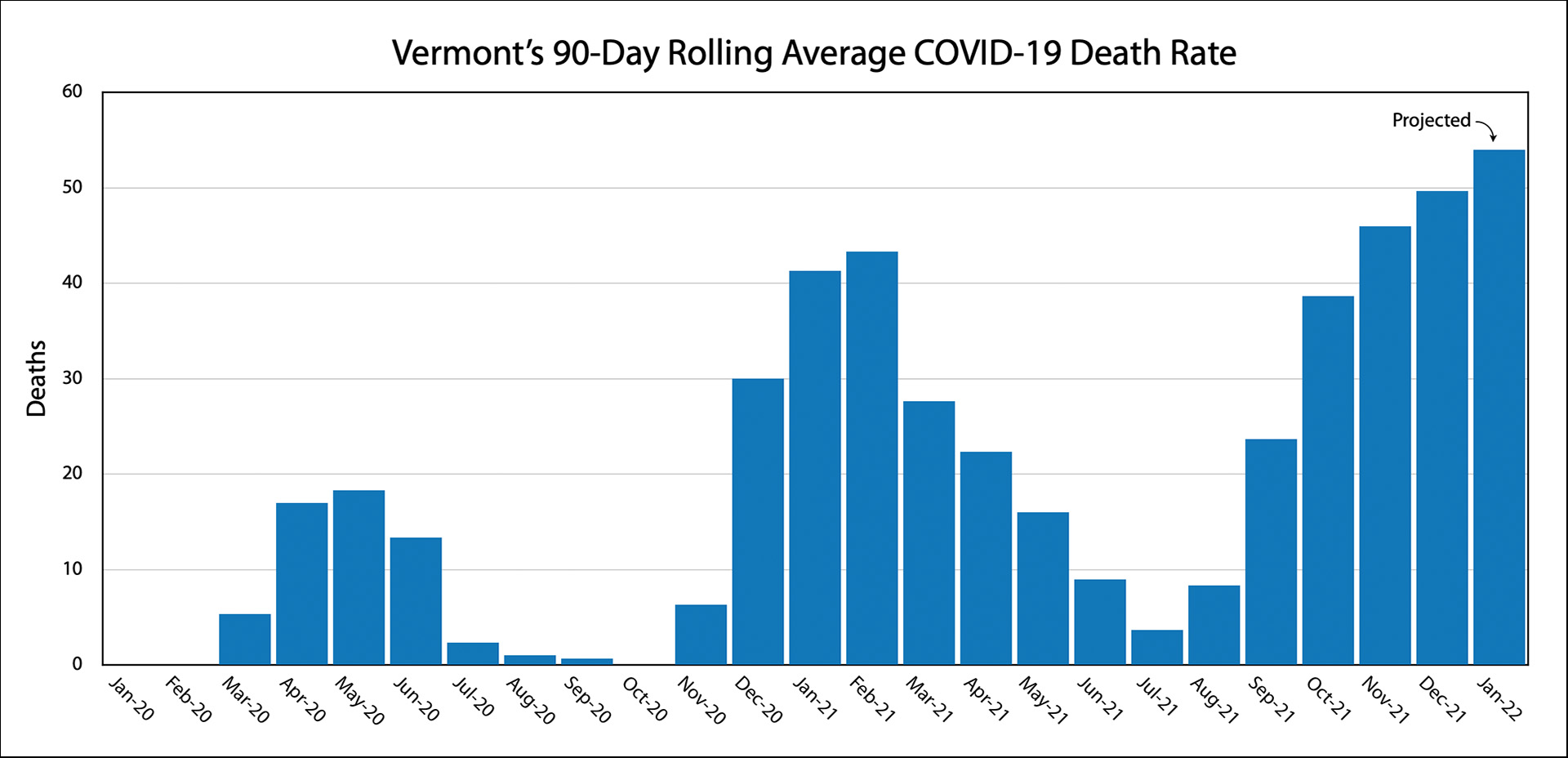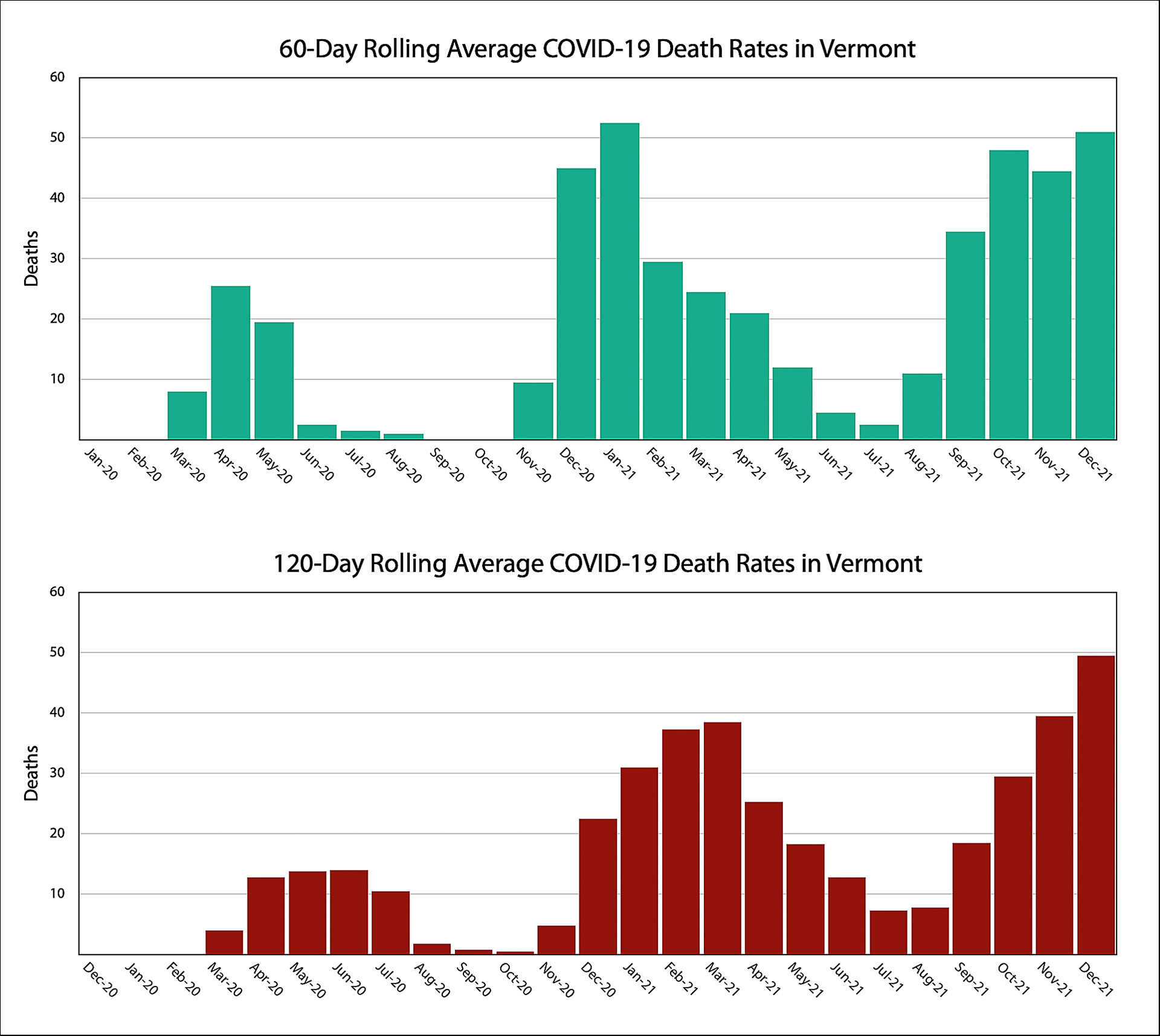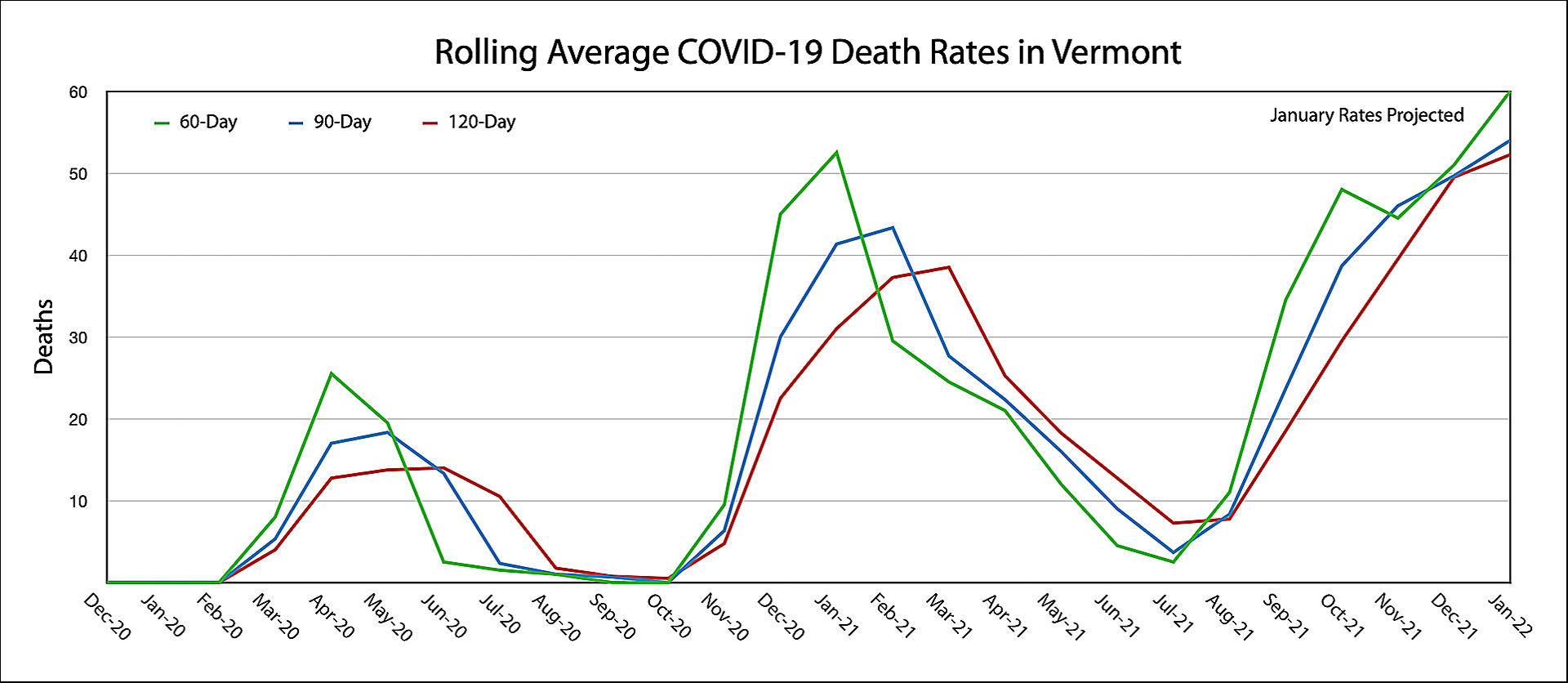The Pandemic's Deadliest Phase
Delta-Omicron is the Most Fatal Wave Yet in Vermont

Note (January 8, 2022): As some of my readers know, in a former life I was a journalist covering health policy for Vermont and national publications. Although I rarely wander back to news writing, this analysis comes in response to what I see as a failure on the part of the press corps and policy makers to point out that COVID deaths are now higher than ever in Vermont — a trend evident as early as November.
The Delta-Omicron wave of coronavirus is killing more Vermonters than during any other phase of the pandemic — extending a trend that has been obvious for nearly two months. And even as curbing fatalities largely drives his COVID response, Gov. Phil Scott has opposed additional mandates intended to protect the state’s most vulnerable people.
Before I try to decode the governor’s rationale, I present to you the numbers about COVID deaths. Yeah, deaths — not case numbers, which are now out of control and increasingly misleading.
Although this plague manifests itself in lots of terrible ways, of course none is more final than death. By that measure, Vermont is at its worst point yet in the pandemic. And the death rate is not expected to improve for at least another month. It could get worse, even if the Omicron wave runs a fast course.
Rather than looking day-by-day or even month-by-month at fatalities, which aren’t as revealing of trends, I instead graphed moving averages based on two-month, three-month and four-month periods, all of which show that Vermont is now experiencing the highest overall fatality rate of any wave of the pandemic. A moving average smooths out fluctuations in sequential data and clarifies longer-term trends. After all, this pandemic has hit Vermont in three waves, each of which lasts several months.
The graph above plots the three-month rolling average1 death rate, which is rising toward two Vermonters dying per day from COVID-19. No matter how you look at it, including the two- or four-month rolling averages, this wave is killing — and will continue to kill — more Vermonters than at any other similar period of the pandemic.
To be sure, Vermont’s single deadliest month came more than a year ago when 71 people died in December of 2020. That was indeed a very bad month. And the governor, when challenged on his policies, has pointed out that we haven’t seen that many monthly deaths since. True. But one month is a bad measure in a long pandemic that sickens and kills in waves.
The rolling average is a better indicator of trends based on previous actual experience — in this case actual deaths over time. In no other three- or four-month period of this pandemic have death counts been higher than the past three or four months of Delta and Omicron. If, as expected, the fatality rate continues for another month, the period from December 2021 through January 2022 will be the two deadliest months of this plague.
Let’s be clear: Your odds of dying from COVID-19 remain exceedingly low in Vermont and most other places.
Let’s be clear: Your odds of dying from COVID-19 remain exceedingly low in Vermont and most other places. At its current fatality rate, COVID-19 is the third leading cause of death in the state behind cancer and heart disease (Full disclosure: my own comorbidity is a damaged heart.) The prospect of death by coronavirus ranks a bit higher than your odds of dying in an accident like a car crash or falling down the stairs.2
Even so, the irony in this wave is that deaths are rising even as we have essentially conquered the virus with vaccines and better medical treatments for people who are infected. Despite our high vaccination rate, despite heroics from our doctors and nurses and other health-care professionals, and despite a laudable response to this plague by Gov. Scott and his administration, we have by the governor’s own measure arrived at our worst point yet in the pandemic.
This trend was evident even when only Delta was the killer, and it was something I pointed out in a short-lived blog post back in November. I sent the post to a few news reporters, eliciting no responses. The death rate has only gotten worse since then. Perhaps Vermont could have done a better job starting in November to bend this curve.
Beyond making testing a more regular part of our lives, which is indeed happening, I don’t have strong feelings on whether Vermont should again limit social gathering sizes or impose some sort of statewide mask mandate or proof-of-vaccination requirement. It would help, of course, if the remaining unvaccinated among us would get their shots. No news there. And no lecture from me. Instead I offer the unvaccinated only what I hear from other older, sicker, more vulnerable Vermonters: you’re a risk to us as we go about our lives, and we’re afraid of you. (Plus, I don’t want you to get sick and die.)
Now that Omicron is here, maybe it’s too late for any of this to help. Yet if Gov. Scott believed early in the pandemic that mandated masking and limits on gathering sizes were appropriate, then why wouldn’t some similar measures, however limited and reasonable, be warranted now that our average death rate is at its highest point ever and, sadly, will probably get worse before it improves?
For those seeking an answer, I hear it weekly from Gov. Scott during his news conferences, although perhaps not this explicitly: Early in the pandemic, when we stayed home and shut down much of the economy, the governor, acting on science and what we knew at the time, guided an exemplary response. Vermont essentially lead the nation and defied comparison to other states. That was great.
Now, however, Gov. Scott recognizes that Vermont need not be incomparable — but instead reasonable compared to most other states. Vermont still has among the country’s lowest hospitalization rates and our death-rate is now bouncing around in the preferable third of the pack to near the top. As much as the governor would like to improve on that — and I’m certain that he would — basically what we’re doing now appears to be acceptable to him when even the best responses to this pandemic really suck.
Given the current death rate, whether that’s reasonable isn’t my call, of course, but rather that of the governor and his team and, now that it’s in session, the Vermont Legislature.
Supplemental Graphs
First, the monthly COVID-19 deaths (featuring that lousy month of December 2020). Next, the 60-day and 120-day rolling averages, illustrating how this current wave will in all likelihood have higher overall fatalities than our two previous waves. Finally, all three rolling averages graphed together, including January forecasts based on the December rate and state modeling, which predicts no improvement in fatalities this month.



References and End Notes
- Vermont COVID-19 Daily Count and Death Data
- Latest COVID-19 Data Report and Modeling (4 Jan 2022)
- The best interview yet with Vermont Health Commissioner Mark Levine comes from David Goodman’s Vermont Conversation — the WDEV radio and VTDigger broadcast and podcast.
- 1 The three-month rolling average for a particular month is the average death rate for that month and the two previous. So December’s rolling average on the graph is the average rate for December, November and October.
- 2 To compare Vermont’s current COVID-19 fatality rate to other causes of death, I consulted the state’s most recent vital statistics report (covering 2019). The current COVID-19 moving average fatality rate equates to approximately 96 deaths per 100,000 Vermonters, which on a yearly basis would be exceeded only by cancer (223 per 100,000) and heart disease 219 per 100,000). Fourth on that list would be accidents at 64.4 per 100,000. Accidents include vehicle crashes, falling, poisoning and other unintentional deaths.
- It would be prudent to point out that early in the pandemic, we probably missed and undercounted some COVID-19 deaths, and are more accurately counting them now. But the difference is unlikely to be great enough to negate any comparison to what we’re seeing now.
